Effect of Coating Palm Oil Clinker Aggregate on the Engineering Properties of Normal Grade Concrete
Abstract
:1. Introduction
2. Pam Oil Clinker (POC)
3. Materials
3.1. Aggregates
3.2. Powders
3.3. Admixtures
4. Experimental Program
- Phase 1: All the aggregate particles were checked to ensure they have been soaked in water for 24 h. They were later brought into the saturated surface dry (SSD) condition to avoid any loss of fluid through absorption during the PP test.
- Phase 2: The combination of the aggregates, i.e., POC coarse, granite coarse and river sand with proportion based on the mix designed by the DOE method, as tabulated in Table 3, was prepared on the baseplate. They were thoroughly mixed by using a scoop and trowel to get a homogenous mix. It was later placed into a container in a loosely packed state, as shown in Figure 5.
- Phase 3: A known volume of clean water was prepared and it was subsequently poured slowly into the container filled with the aggregates.
- Phase 4: Once the water level reached the top surface of the container, the water level is checked consecutively every 30 s for a period of 2 min. This is basically to allow for water to fill up all the voids between the aggregates. Water is constantly added if there is a reduction in the level. The amount of water utilized represents the total amount of voids present.
Determination of the Required POCP
5. Coating Process and Concrete Mixing
6. Results and Discussion
6.1. Workability
6.2. Fresh Density
6.3. Compressive Strength
6.4. Splitting Tensile Strength
6.5. Flexural Strength
6.6. Modulus of Elasticity
6.7. Water Absorption
6.8. Drying Shrinkage
6.9. Chloride Permeability
7. Conclusions
- POC, being highly porous had a negative effect on the fresh and hardened concrete properties when the coarse aggregate is substituted with POC. However, incorporating additional POCP into the POC concrete mixes resulted in increasing the paste content required to make the mixes more cohesive. POCP together with SP proved to be beneficial to the workability of the POC concrete mixes.
- In general, there was reduction in the compressive strength when POC coarse aggregate was used. The concrete strength was lower when a higher content of conventional aggregate was substituted with the POC. At 28 days, the compressive strength of the POC concrete obtained was in the range between 33.01 and 39.32 MPa. Meanwhile, a significant reduction in compressive strength was avoided when POC coarse was coated using POCP as a filler material to the surface voids. Thus, the compressive strength of the POCP concrete increased by 20% to 30% compared to the mixes before coating.
- Splitting tensile strength results of the POC concrete generally showed a trend similar to that observed in the compressive strength. The higher the contents of POC coarse, the lower the splitting tensile value. At 28 days, the splitting tensile of the POC concrete was in the range of 2.61 to 3.28 MPa. The maximum reduction was at full replacement of POC, which registered a value of 27% lower than the control concrete. Meanwhile, the POCP concrete recorded an increased ranging between 10% and 31% with respect to POC concrete mixes (pre-coating).
- All of the POC concrete mixes had slightly lower flexural strength values when compared to that of the control concrete. At 28 days, the flexural strength of the POC concrete was in the range of 3.75 to 4.42 MPa. The maximum reduction was at full replacement with approximately 15% lower than the control concrete. However, a significant increase in flexural strength was achieved when POCP was used in the POC concrete mixtures. The improvement was in the range of 5%–25% higher when compared to the POC concrete.
- Incorporation of the POC coarse negatively affected the MOE value of the concrete. The MOE of the POC concrete dropped by 9% to 31% lower than that of the control concrete. However, the POCP concrete had a 28-day MOE values range of between 28 and 32 GPa which was 14%–46% higher than that of the POC concrete (pre-coating).
- POC concrete mixes had higher water absorption when compared to the control mix and tends to rise with an increasing POC coarse contents. However, the addition of POCP resulted in a decrease in the value of water absorption when compared to the POC concrete by reducing the pore size, which resulted in highly densified paste.
- Specimens containing additional POCP exhibited a greater chloride-ion resistance as compared to POC mixes, as well as to the control concrete. At 28 days, the charge passed of the POCP concrete was in the range of 12% to 70%, lower than that the POC concrete.
- The results revealed that coating the surface voids of POC coarse with POCP significantly improved the engineering properties as well as the durability performance of the POC concrete. Thus, using POC as an aggregate and filler material may reduce the continuous exploitation of aggregates from primary sources. Also, this approach offers an environmentally friendly solution to the ongoing problems of palm oil waste material.
Acknowledgments
Author Contributions
Conflicts of Interest
Appendix A
- The void volume (VVoid) using PP method for all the POC concrete mixes is determined by adopting Equations (A1) and (A2). This is represented by the volume of water (VPPwater) required to fill up the PP container for different substitution levels of POC coarse as well as for the control mix. Please change the following equations to be Editable state.
- Equation (A3) is adopted to determine the percentage of void increment resulting from each replacement level of POC coarse in which the PP control mix void volume (VPPcontrolVoid) is taken as a benchmark.
- Adjust the control paste volume using Equation (A4), multiplying the PP paste volume by the correction factor:
- The total paste volume required for different substitution level of POC concrete (VTotalPaste) is calculated using (Equation A5) by increasing the control cement paste volume (VControlPaste) with the percentage of void increment obtained in Equation (A3).
- The volume of the additional POCP (VPOCP) is obtained using Equation (A6) by deducting the control paste volume (VControlPaste) from the total paste volume (VTotalPaste) obtained in Equation (A5). Equation (A7) represents the additional POCP in kg/m3.where SGPOCP is Specific Gravity of POCP.
| Column | A | B | C | D | E | F | G | K | L |
|---|---|---|---|---|---|---|---|---|---|
| ID | PP Water Vol. (m3) | PP Container Vol. (m3) | Void Vol. (m3/m3) | Void Increment (%) | Control Mix Correction Factor | Control Paste Vol. (m3/m3) 0.3049 × 1.16 | Total Paste Vol. (m3/m3) | POCP Vol. Required (m3/m3) G-0356 | POCP (kg/m3) K × POCPSG |
| M0 | 0.00057 | 0.0018696 | 0.3049 | – | 1.16 | 0.356 | 0.356 | – | – |
| POCP20 | 0.00062 | 0.0018696 | 0.3289 | 7.92 | – | – | 0.384 | 0.028 | 70 |
| POCP40 | 0.00063 | 0.0018696 | 0.337 | 10.55 | – | – | 0.393 | 0.037 | 93 |
| POCP60 | 0.00064 | 0.0018696 | 0.3423 | 12.31 | – | – | 0.399 | 0.043 | 108 |
| POCP80 | 0.00067 | 0.0018696 | 0.3584 | 17.57 | – | – | 0.418 | 0.062 | 156 |
| POCP100 | 0.0007 | 0.0018696 | 0.3744 | 22.84 | – | – | 0.437 | 0.081 | 203 |
References
- Rashid, M.A.; Salam, M.A.; Shill, S.K.; Hasan, M.K. Effect of replacing natural coarse aggregate by brick aggregate on the properties of concrete. Dhaka Univ. Eng. Technol. J. 2012, 1, 17–22. [Google Scholar]
- Katz, A. Properties of concrete made with recycled aggregate from partially hydrated old concrete. Cem. Concr. Res. 2003, 33, 703–711. [Google Scholar] [CrossRef]
- Alnahhal, M.F.; Alengaram, U.J.; Jumaat, M.Z.; Alqedra, M.A.; Mo, K.H.; Sumesh, M. Evaluation of industrial by–products as sustainable pozzolanic materials in recycled aggregate concrete. Sustainability 2017, 9, 767. [Google Scholar] [CrossRef]
- Mannan, M.; Neglo, K. Mix design for oil–palm–boiler clinker (OPBC) concrete. J. Sci. Technol. 2010, 30, 111–118. [Google Scholar] [CrossRef]
- Hosseini, S.E.; Wahid, M.A. Utilization of palm solid residue as a source of renewable and sustainable energy in malaysia. Renew. Sustain. Energy Rev. 2014, 40, 621–632. [Google Scholar] [CrossRef]
- Halimah, M.; Tan, Y.A.; Nik Sasha, K.K.; Zuriati, Z.; Rawaida, A.I.; Choo, Y.M. Determination of life cycle inventory and greenhouse gas emissions for a selected oil palm nursery in malaysia: A case study. J. Oil Palm Res. 2013, 25, 343–347. [Google Scholar]
- Kanadasan, J.; Razak, H.A. Mix design for self–compacting palm oil clinker concrete based on particle packing. Mater. Des. 2014, 56, 9–19. [Google Scholar] [CrossRef]
- Fuad Abutaha, H.A.R. Jegathish Kanadasan. Effect of palm oil clinker (POC) aggregates on fresh and hardened properties of concrete. Constr. Build. Mater. 2016, 112, 416–423. [Google Scholar] [CrossRef]
- Kanadasan, J.; Fauzi, A.F.A.; Razak, H.A.; Selliah, P.; Subramaniam, V.; Yusoff, S. Feasibility studies of palm oil mill waste aggregates for the construction industry. Materials 2015, 8, 6508–6530. [Google Scholar] [CrossRef] [PubMed]
- Abdullahi, M.; Al-Mattarneh, H.; Hassan, A.A.; Hassan, M.; Mohammed, B. Trial mix design methodology for palm oil clinker (POC) concrete. In Proceedings of the International Conference on Construction and Building Technology, Kuala Lumpur, Malaysia, 16–20 June 2008. [Google Scholar]
- Ibrahim, H.A.; Razak, H.A. Effect of palm oil clinker incorporation on properties of pervious concrete. Constr. Build. Mater. 2016, 115, 70–77. [Google Scholar] [CrossRef]
- Kanadasan, J.; Abdul Razak, H. Utilization of palm oil clinker as cement replacement material. Materials 2015, 8, 8817–8838. [Google Scholar] [CrossRef] [PubMed]
- Karim, M.R.; Hashim, H.; Razak, H.A. Assessment of pozzolanic activity of palm oil clinker powder. Constr. Build. Mater. 2016, 127, 335–343. [Google Scholar] [CrossRef]
- Mangulkar, M.; Jamkar, S. Review of particle packing theories used for concrete mix proportioning. Int. J. Sci. Eng. Res. 2013, 4, 143–148. [Google Scholar]
- Koehler, E.P. Aggregates in Self-Consolidating Concrete; Final Report; International Center for Aggregate Research (ICAR) Report; University of Texas: Austin, TX, USA, 2007. [Google Scholar]
- Kanadasan, J.; Razak, H.A. Engineering and sustainability performance of self–compacting palm oil mill incinerated waste concrete. J. Clean. Prod. 2015, 89, 78–86. [Google Scholar] [CrossRef]
- Abutaha, F.; Abdul Razak, H.; Kanadasan, J. Effect of palm oil clinker (POC) aggregates on fresh and hardened properties of concrete. Constr. Build. Mater. 2016, 112, 416–423. [Google Scholar] [CrossRef]
- Ibrahim, H.A.; Abdul Razak, H.; Abutaha, F. Strength and abrasion resistance of palm oil clinker pervious concrete under different curing method. Constr. Build. Mater. 2017, 147, 576–587. [Google Scholar] [CrossRef]
- Tuan, B.L.A.; Hwang, C.-L.; Lin, K.-L.; Chen, Y.-Y.; Young, M.-P. Development of lightweight aggregate from sewage sludge and waste glass powder for concrete. Constr. Build. Mater. 2013, 47, 334–339. [Google Scholar] [CrossRef]
- Mannan, M.A.; Ganapathy, C. Engineering properties of concrete with oil palm shell as coarse aggregate. Constr. Build. Mater. 2002, 16, 29–34. [Google Scholar] [CrossRef]
- Teo, D.; Mannan, M.; Kurian, V. Structural concrete using oil palm shell (OPS) as lightweight aggregate. Turk. J. Eng. Environ. Sci. 2006, 30, 251–257. [Google Scholar]
- Abdullah, A. Palm oil shell aggregate for lightweight concrete. In Waste Materials Used in Concrete Manufacturing; Chandra, S., Ed.; Noyes Publ.: Westwood, NJ, USA, 1996; pp. 624–636. [Google Scholar]
- Shafigh, P.; Jumaat, M.Z.; Mahmud, H.B.; Hamid, N.A.A. Lightweight concrete made from crushed oil palm shell: Tensile strength and effect of initial curing on compressive strength. Constr. Build. Mater. 2012, 27, 252–258. [Google Scholar] [CrossRef]
- Haque, M.; Al-Khaiat, H.; Kayali, O. Strength and durability of lightweight concrete. Cem. Concr. Compos. 2004, 26, 307–314. [Google Scholar] [CrossRef]
- Holm, T.A.; Bremner, T.W. State of the Art Report on High-Strength, High-Durability Structural Low-Density Concrete for Applications in Severe Marine Environments; US Army Corps of Engineers, Engineer Research and Development Center: Vicksburg, MS, USA, 2000. [Google Scholar]
- ASTM International. Standard Test Method for Splitting Tensile Strength of Cylindrical Concrete Specimens; ASTM International: West Conshohocken, PA, USA, 2011. [Google Scholar]
- Smadi, M.; Migdady, E. Properties of high strength tuff lightweight aggregate concrete. Cem. Concr. Compos. 1991, 13, 129–135. [Google Scholar] [CrossRef]
- Neville, A.M. Properties of Concrete, 14th ed.; Prentice Hall: Upper Saddle River, NJ, USA, 2008. [Google Scholar]
- Gesoğlu, M.; Özturan, T.; Güneyisi, E. Shrinkage cracking of lightweight concrete made with cold-bonded fly ash aggregates. Cem. Concr. Res. 2004, 34, 1121–1130. [Google Scholar] [CrossRef]
- Okafor, F.O. Palm kernel shell as a lightweight aggregate for concrete. Cem. Concr. Res. 1988, 18, 901–910. [Google Scholar] [CrossRef]
- Mahmud, H. Ductility behaviour of reinforced palm kernel shell concrete beams. Eur. J. Sci. Res. 2008, 23, 406–420. [Google Scholar]
- Shetty, M.S. Concrete Technology Theory and Practice; S. Chand & Company Ltd.: New Delhi, India, 2005. [Google Scholar]
- Krizova, K.; Hela, R. Selected Technological Factors Influencing the Modulus of Elasticity of Concrete. World Acad. Sci. Eng. Technol. Int. J. Civ. Environ. Struct. Constr. Archit. Eng. 2014, 8, 593–595. [Google Scholar]
- Domagała, L. Modification of properties of structural lightweight concrete with steel fibres. J. Civ. Eng. Manag. 2011, 17, 36–44. [Google Scholar] [CrossRef]
- ACI 318-08 Building Code Requirements for Structural Concrete and Commentary; ACI Standard; American Concrete Institute: Farmington Hills, MI, USA, 2008; p. 465.
- Hossain, K.; Ahmed, S.; Lachemi, M. Lightweight concrete incorporating pumice based blended cement and aggregate: Mechanical and durability characteristics. Constr. Build. Mater. 2011, 25, 1186–1195. [Google Scholar] [CrossRef]
- Tasnimi, A. Mathematical model for complete stress-strain curve prediction of normal, light-weight and high-strength concretes. Mag. Concr. Res. 2004, 56, 23–34. [Google Scholar] [CrossRef]
- Noguchi, T.; Tomosawa, F.; Nemati, K.M.; Chiaia, B.M.; Fantilli, A.P. A practical equation for elastic modulus of concrete. ACI Struct. J. 2009, 106, 690. [Google Scholar]
- BS 8110: Part 2, Structural Use of Concrete. Part 2: Code of Practice for Special Circumstances. British Standards Institution: London, UK, 1985.
- Australian Standard. General Purpose and Blended Cements; Australian Standard: Sydney, Australia, 2014. [Google Scholar]
- Nilson, A.H.; Martinez., S. Mechanical properties of high-strength lightweight concrete. Aci Mater. J. 1991, 88, 240–247. [Google Scholar]
- BSI BS 1881: Part 122. Method for Determination of Water Absorption. British Standard Institution: London, UK, 1983.
- Wongkeo, W.; Thongsanitgarn, P.; Ngamjarurojana, A.; Chaipanich, A. Compressive strength and chloride resistance of self-compacting concrete containing high level fly ash and silica fume. Mater. Des. 2014, 64, 261–269. [Google Scholar] [CrossRef]
- Teo, D.; Mannan, M.; Kurian, V. Durability of lightweight OPS concrete under different curing conditions. Mater. Struct. 2010, 43, 1–13. [Google Scholar] [CrossRef]
- Topcu, I.B. Physical and mechanical properties of concretes produced with waste concrete. Cem. Concr. Res. 1997, 27, 1817–1823. [Google Scholar] [CrossRef]
- Moosberg-Bustnes, H.; Lagerblad, B.; Forssberg, E. The function of fillers in concrete. Mater. Struct. 2004, 37, 74–81. [Google Scholar] [CrossRef]
- Tangchirapat, W.; Jaturapitakkul, C.; Chindaprasirt, P. Use of palm oil fuel ash as a supplementary cementitious material for producing high-strength concrete. Constr. Build. Mater. 2009, 23, 2641–2646. [Google Scholar] [CrossRef]
- Ahmad, M.H.; Mohd Noor, N.; Adnan, S.H. Shrinkage of Malaysian palm oil clinker concrete. In Proceedings of the International Conference on Civil Engineering Practice (ICCE08), Kuantan, Pahang, 12–14 May 2008. [Google Scholar]
- Chia, K.S.; Zhang, M.-H. Water permeability and chloride penetrability of high-strength lightweight aggregate concrete. Cem. Concr. Res. 2002, 32, 639–645. [Google Scholar] [CrossRef]
- Shi, C. Another Look at the Rapid Chloride Permeability Test (Astm C1202 or Asshto T277); FHWA Resource Center: Baltimore, MD, USA, 2003. [Google Scholar]
- Stanish, K.D.; Hooton, R.D.; Thomas, M.D.A. Testing the Chloride Penetration Resistance of Concrete: A Literature Review; University of Toronto: Toronto, ON, Canada, 2000. [Google Scholar]
- Smith, D. The Development of a Rapid Test for Determining the Transport Properties of Concrete. Master’s Thesis, University of New Brunswick, Fredericton, NB, Canada, November 2006. [Google Scholar]
- Joshi, P.; Chan, C. Rapid chloride permeability testing. Concr. Constr. 2002, 47, 37–43. [Google Scholar]
- Uysal, M.; Yilmaz, K.; Ipek, M. The effect of mineral admixtures on mechanical properties, chloride ion permeability and impermeability of self-compacting concrete. Constr. Build. Mater. 2012, 27, 263–270. [Google Scholar] [CrossRef]
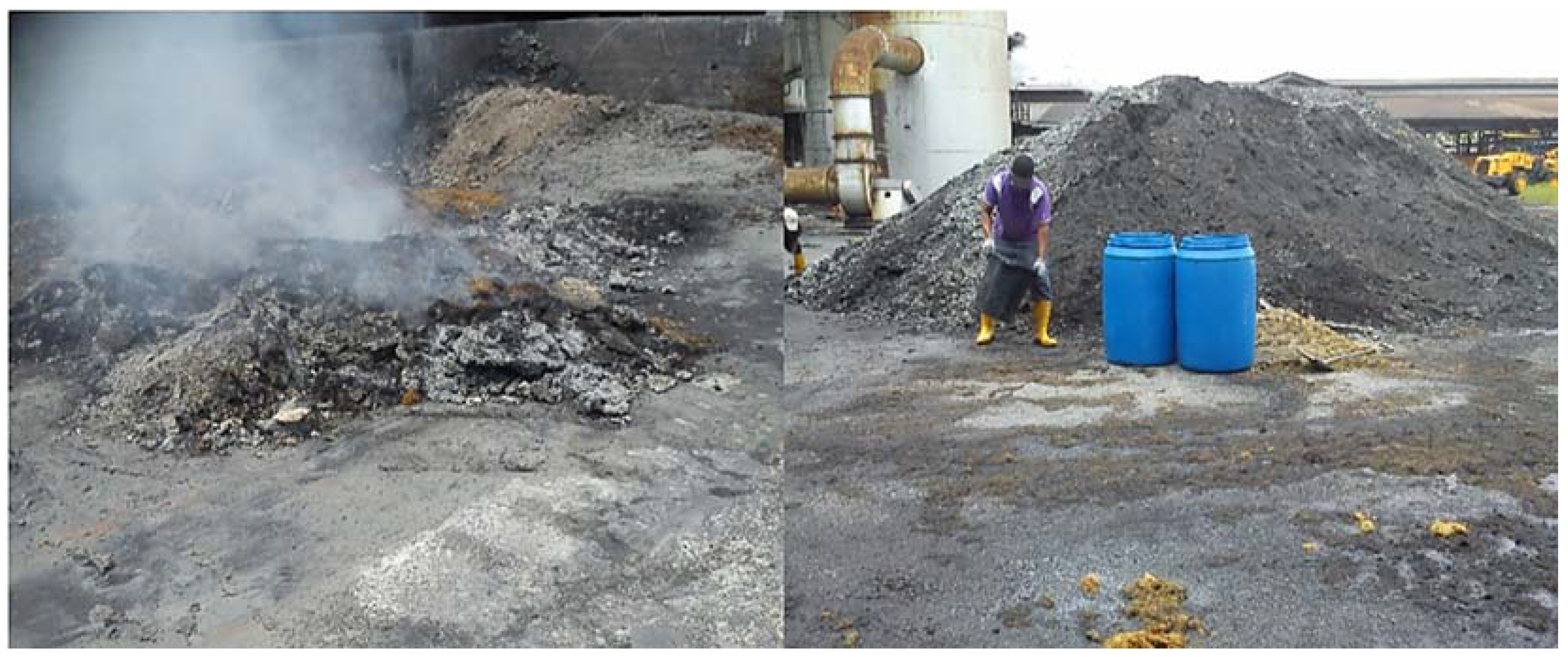
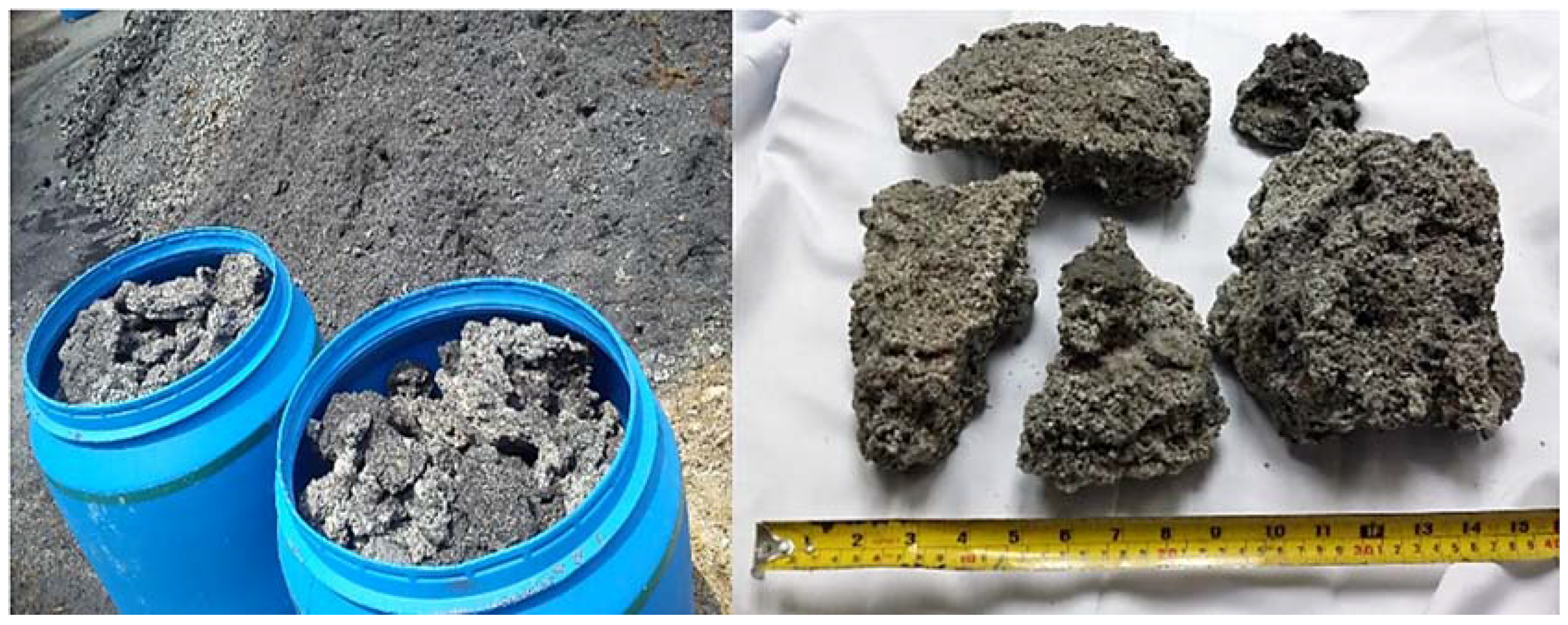
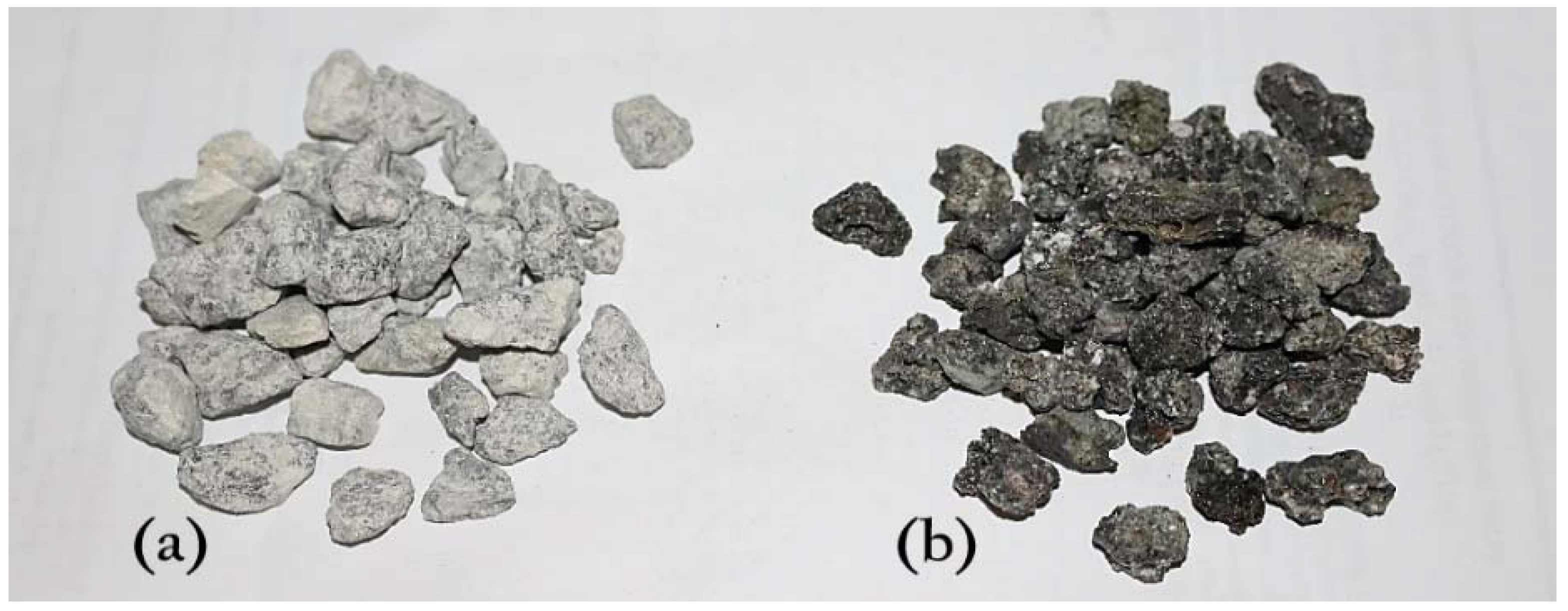
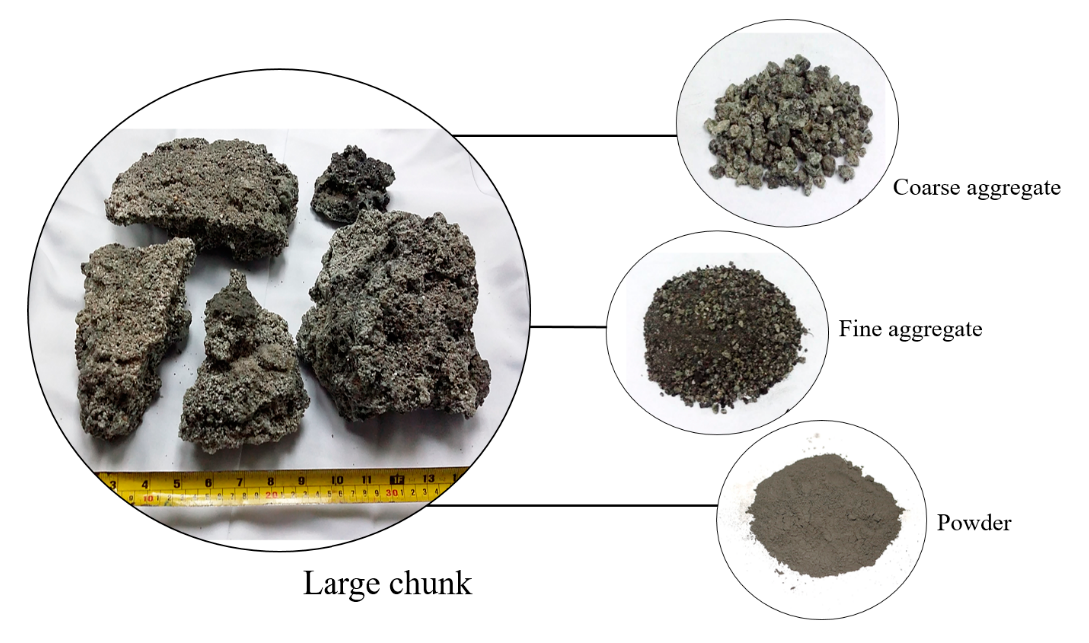
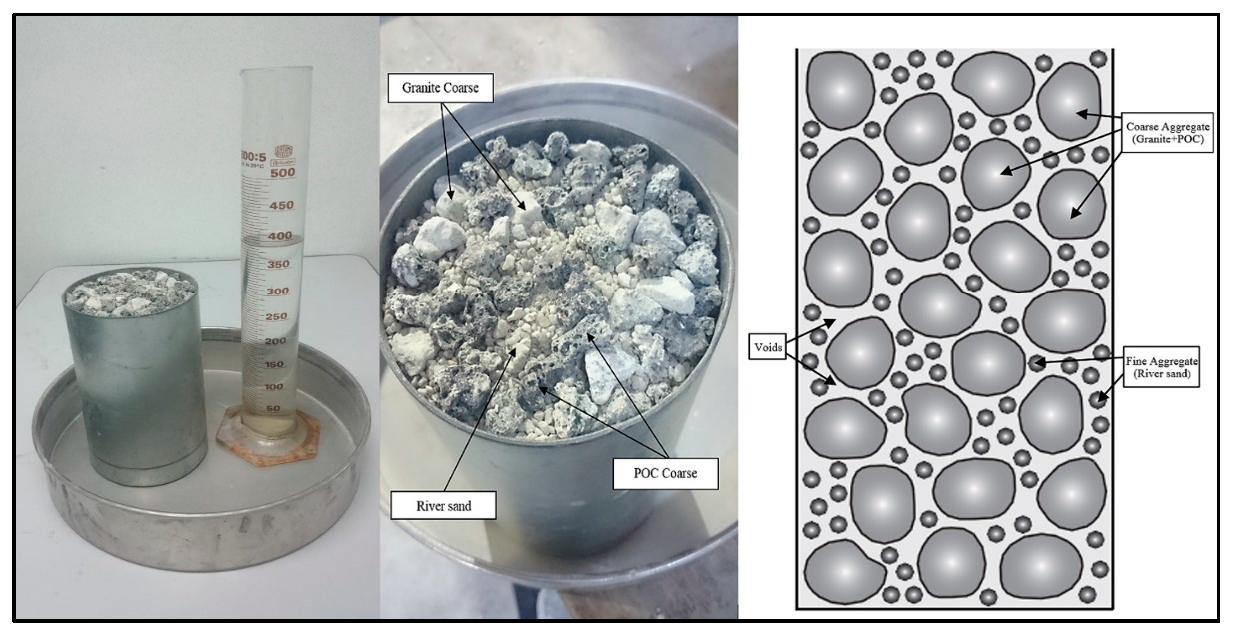
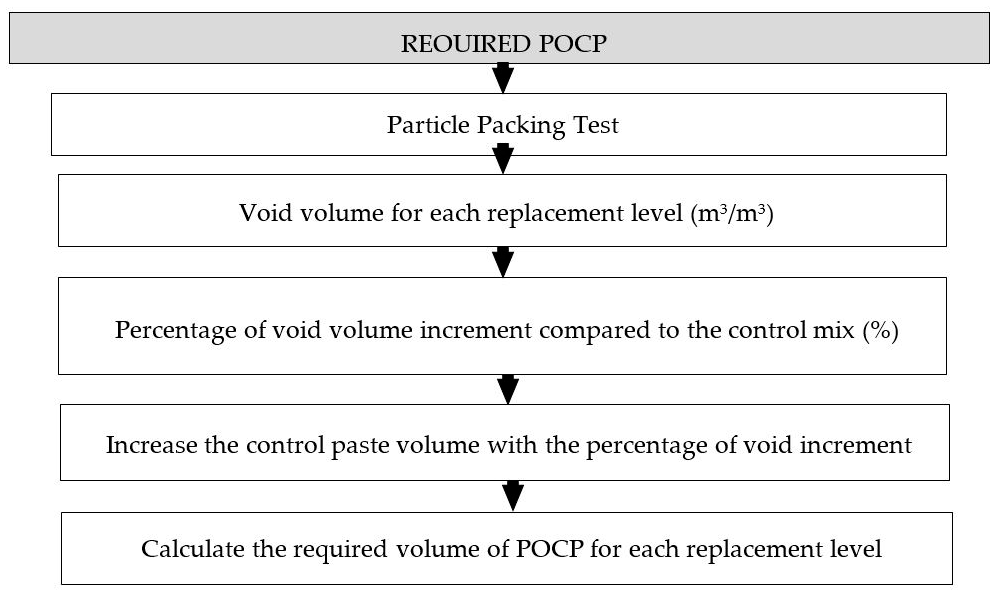
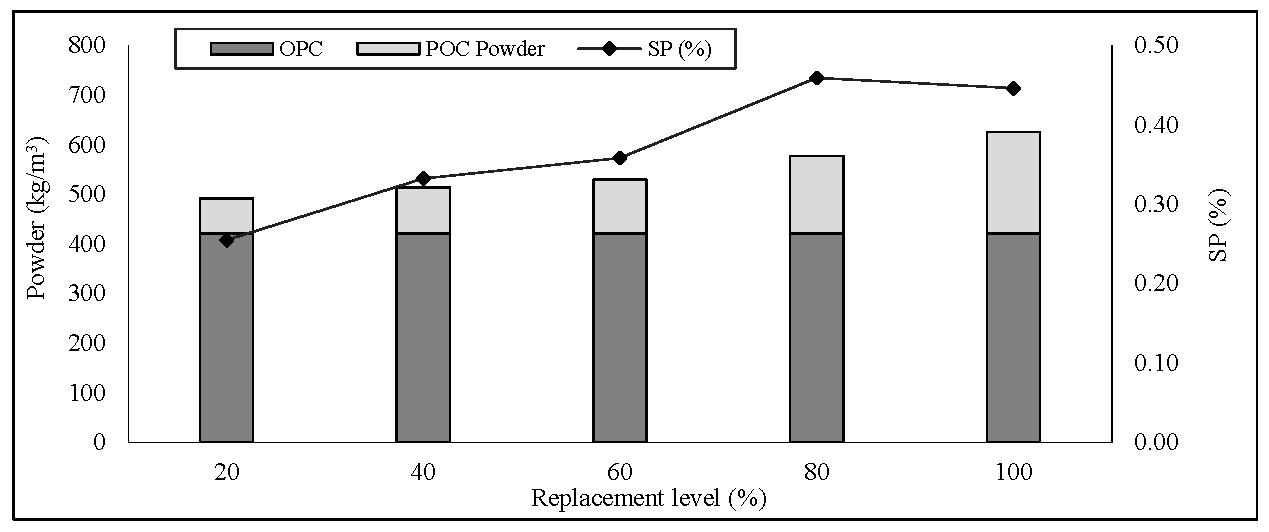
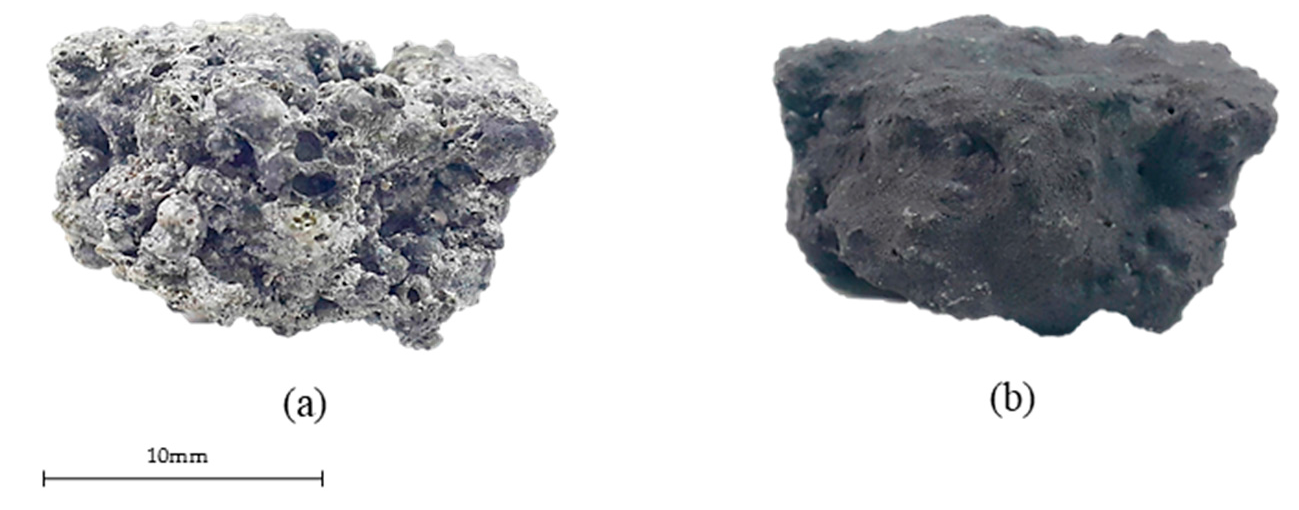
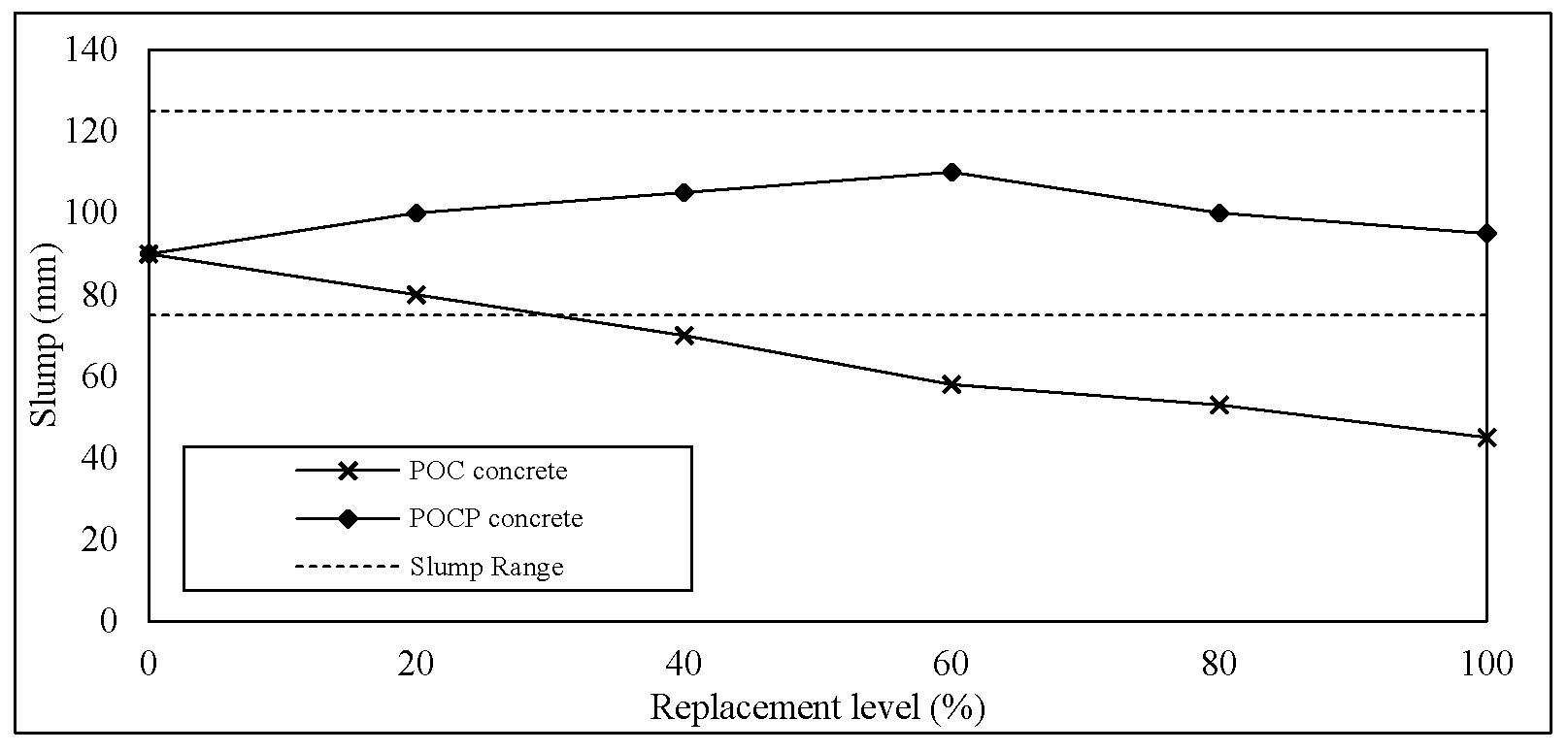
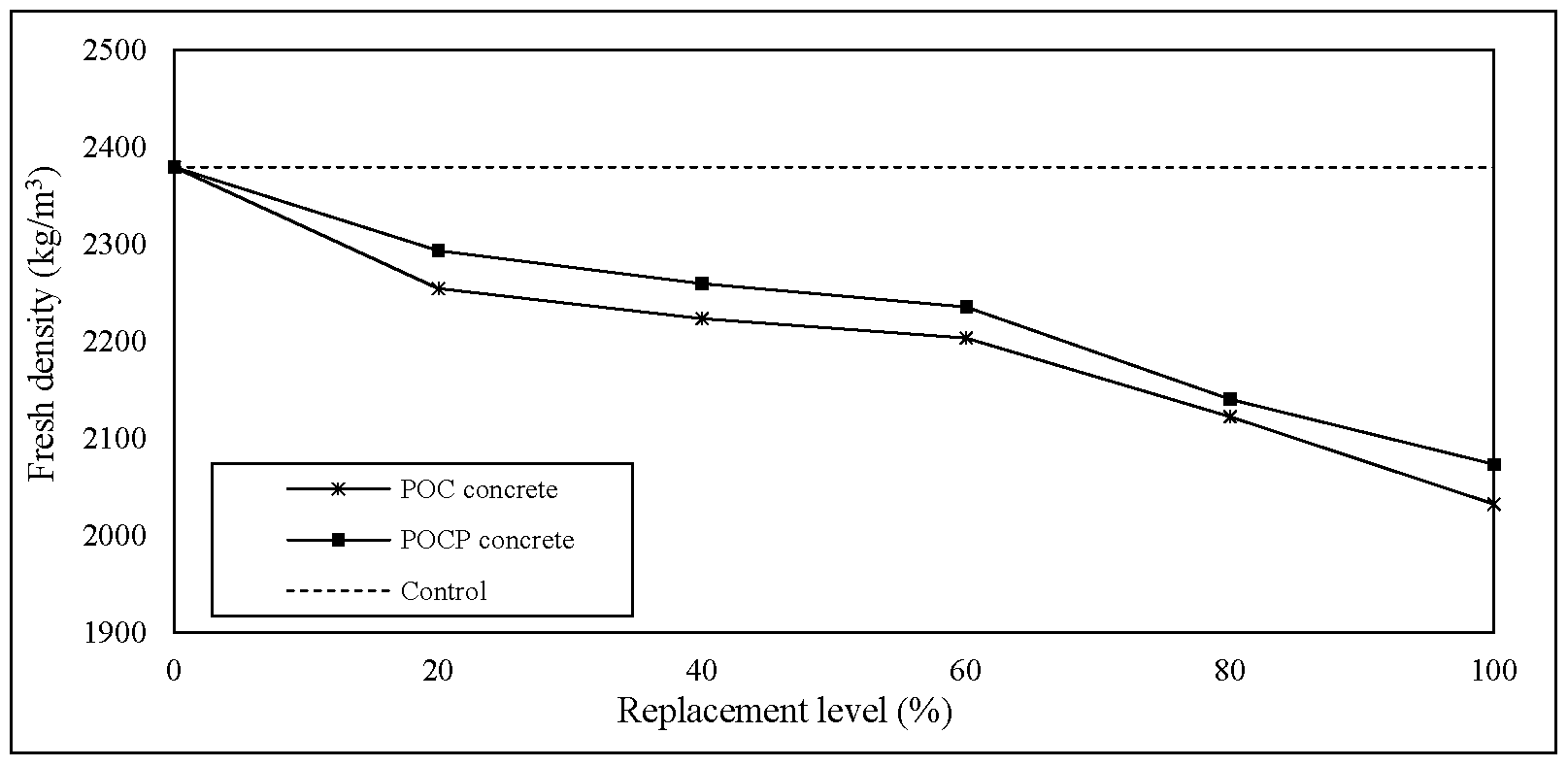
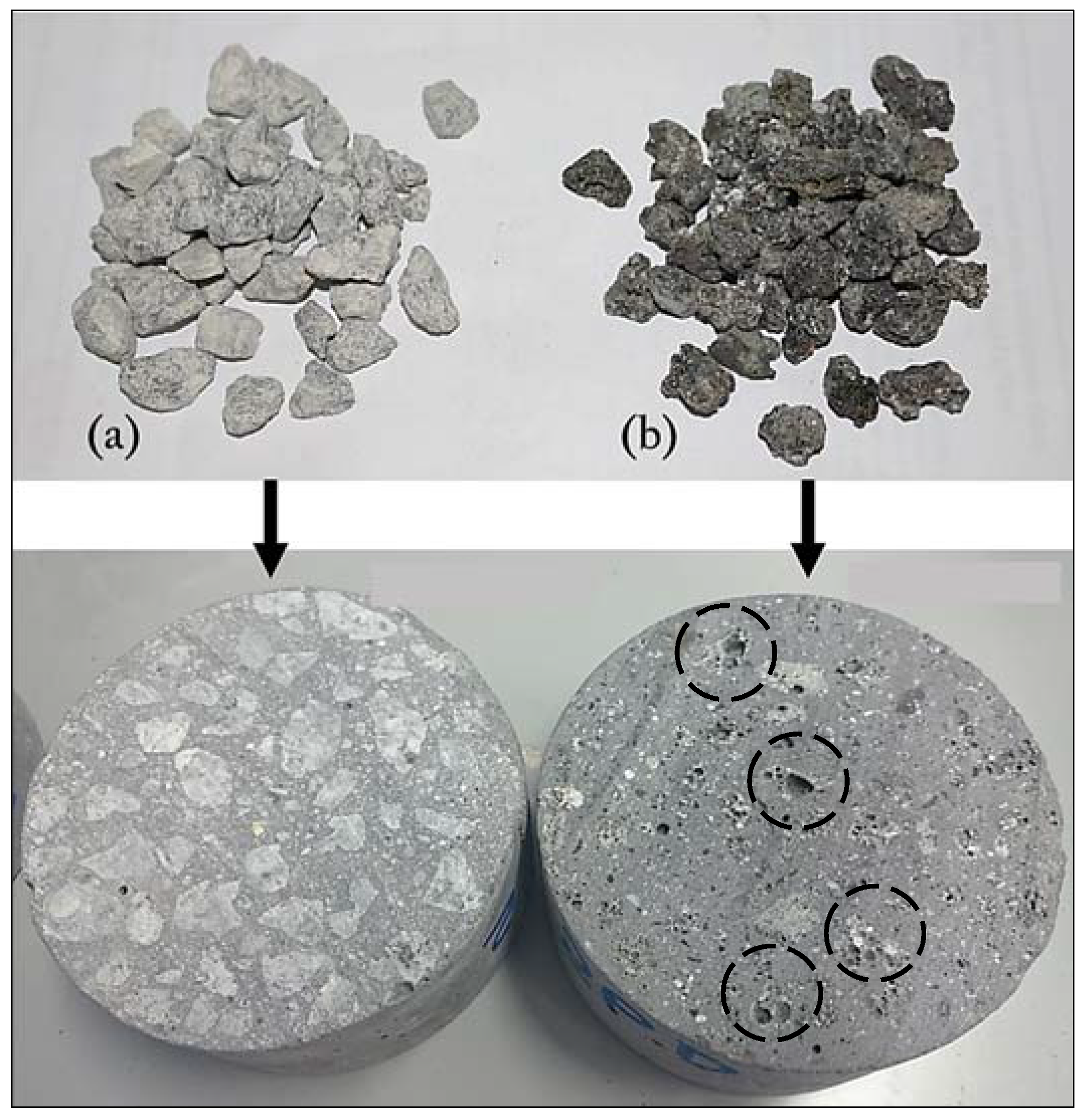
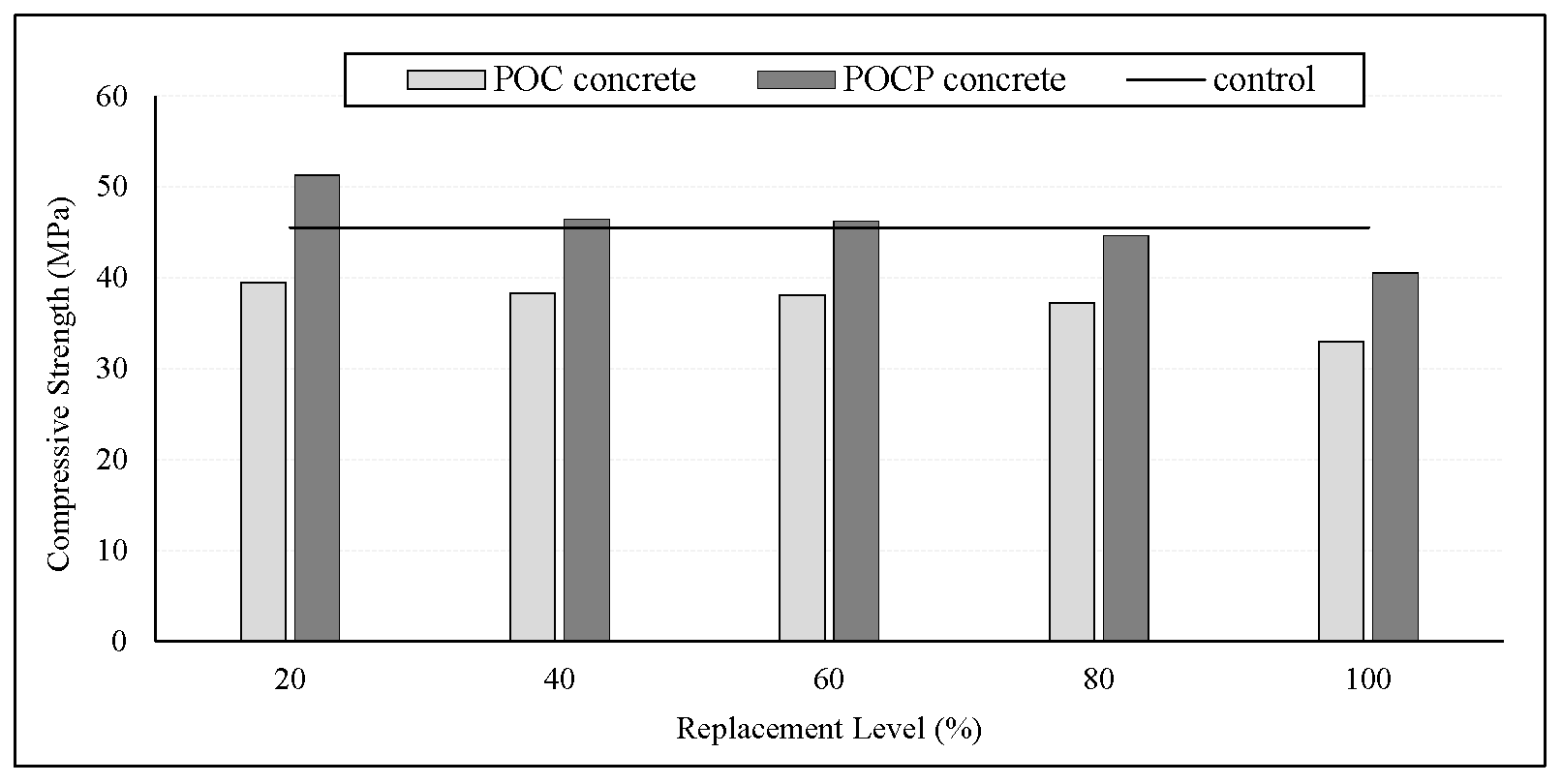
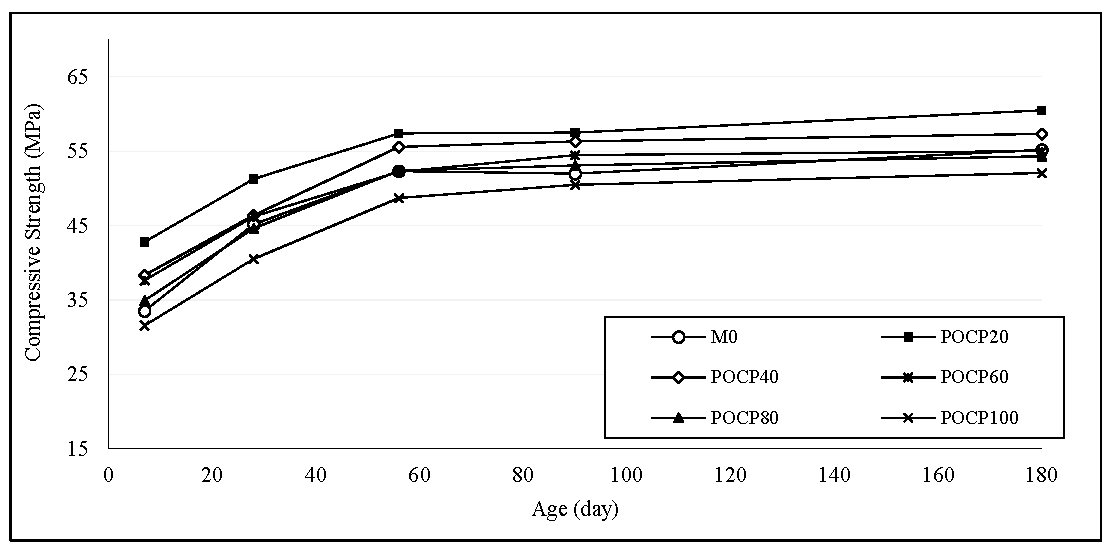
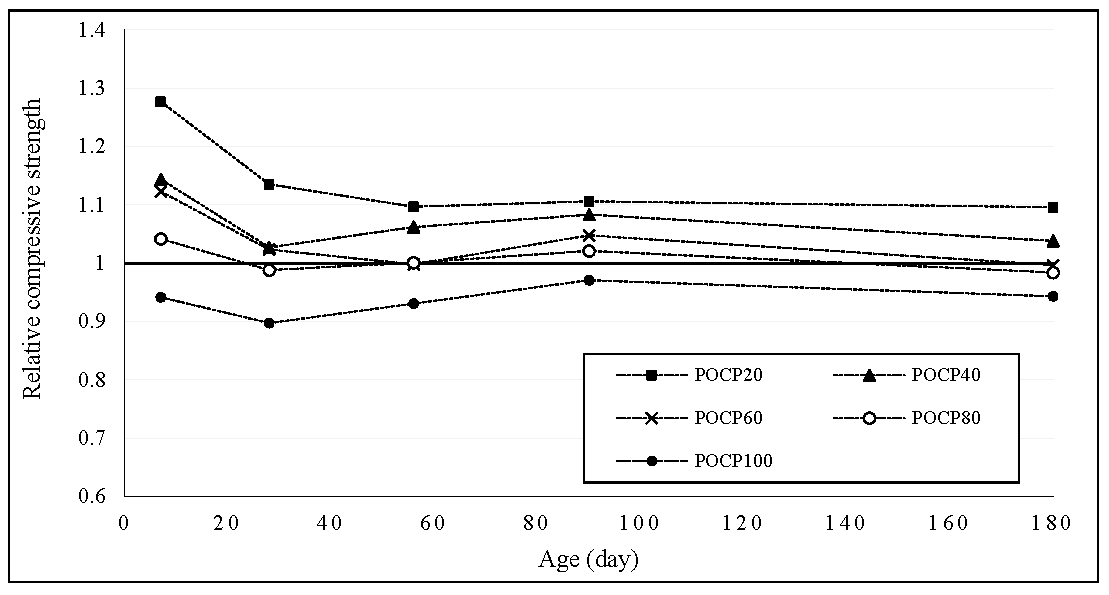
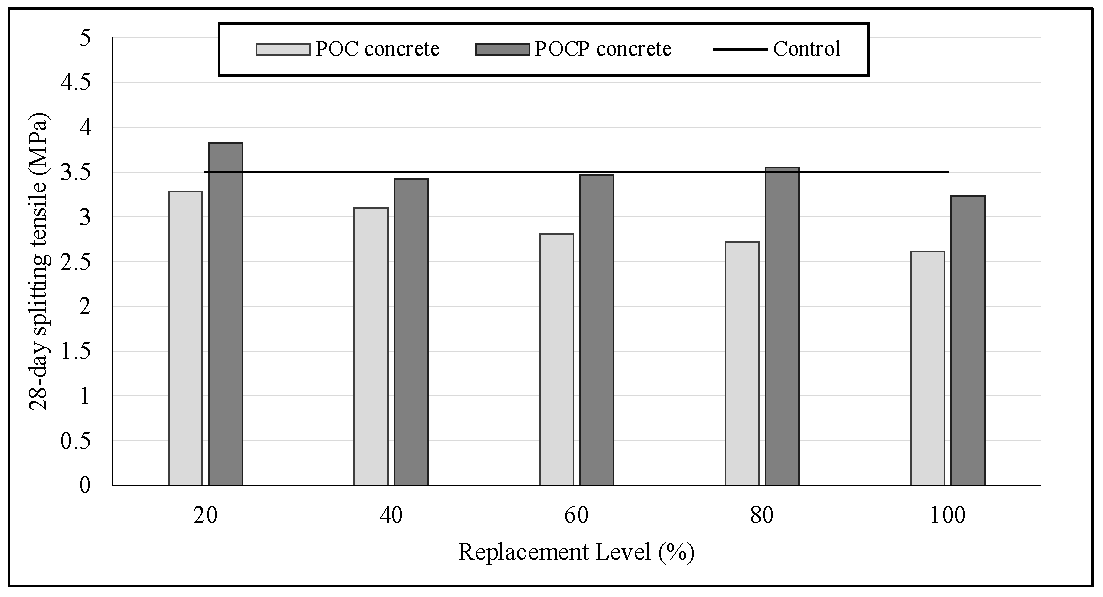
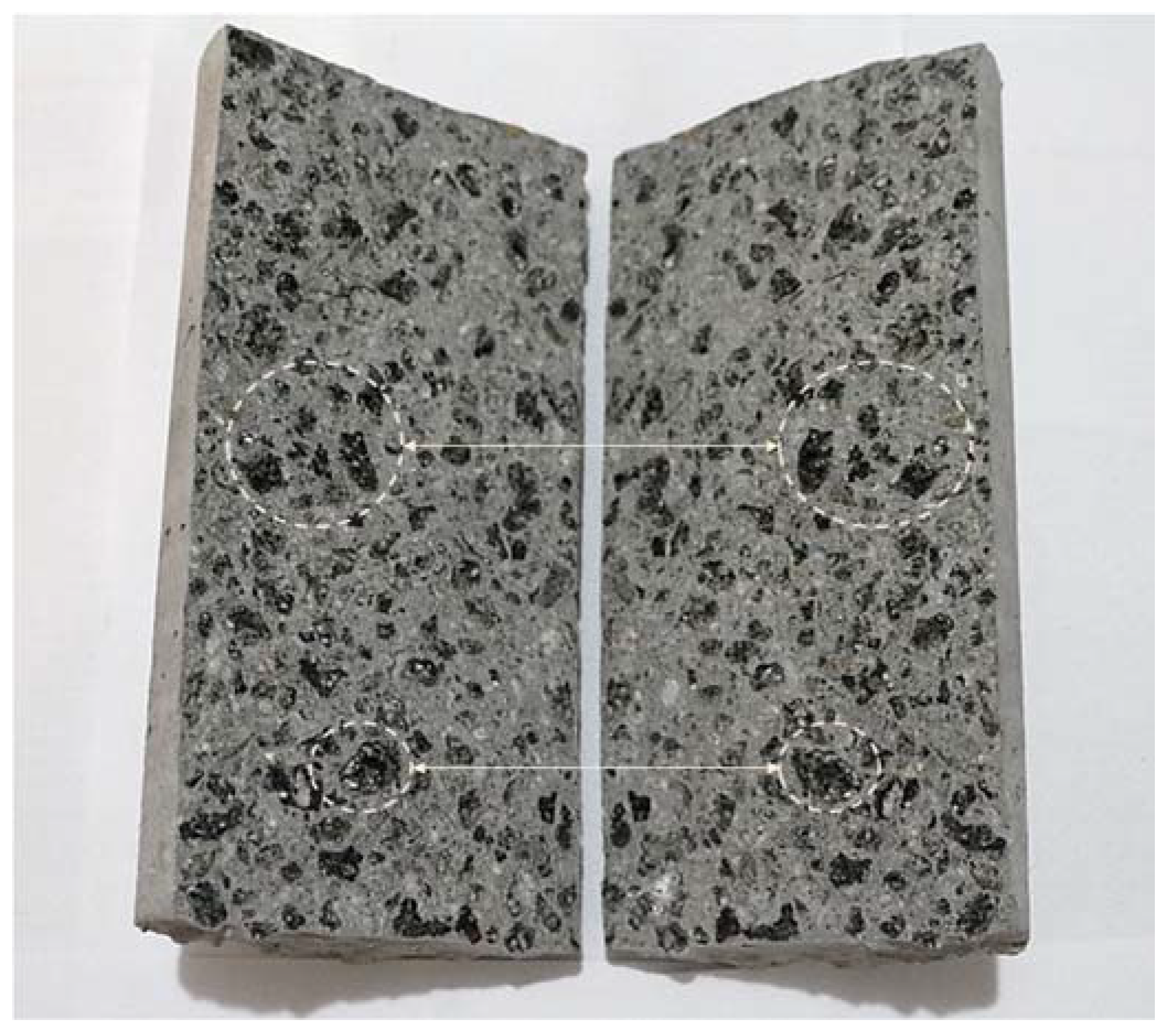
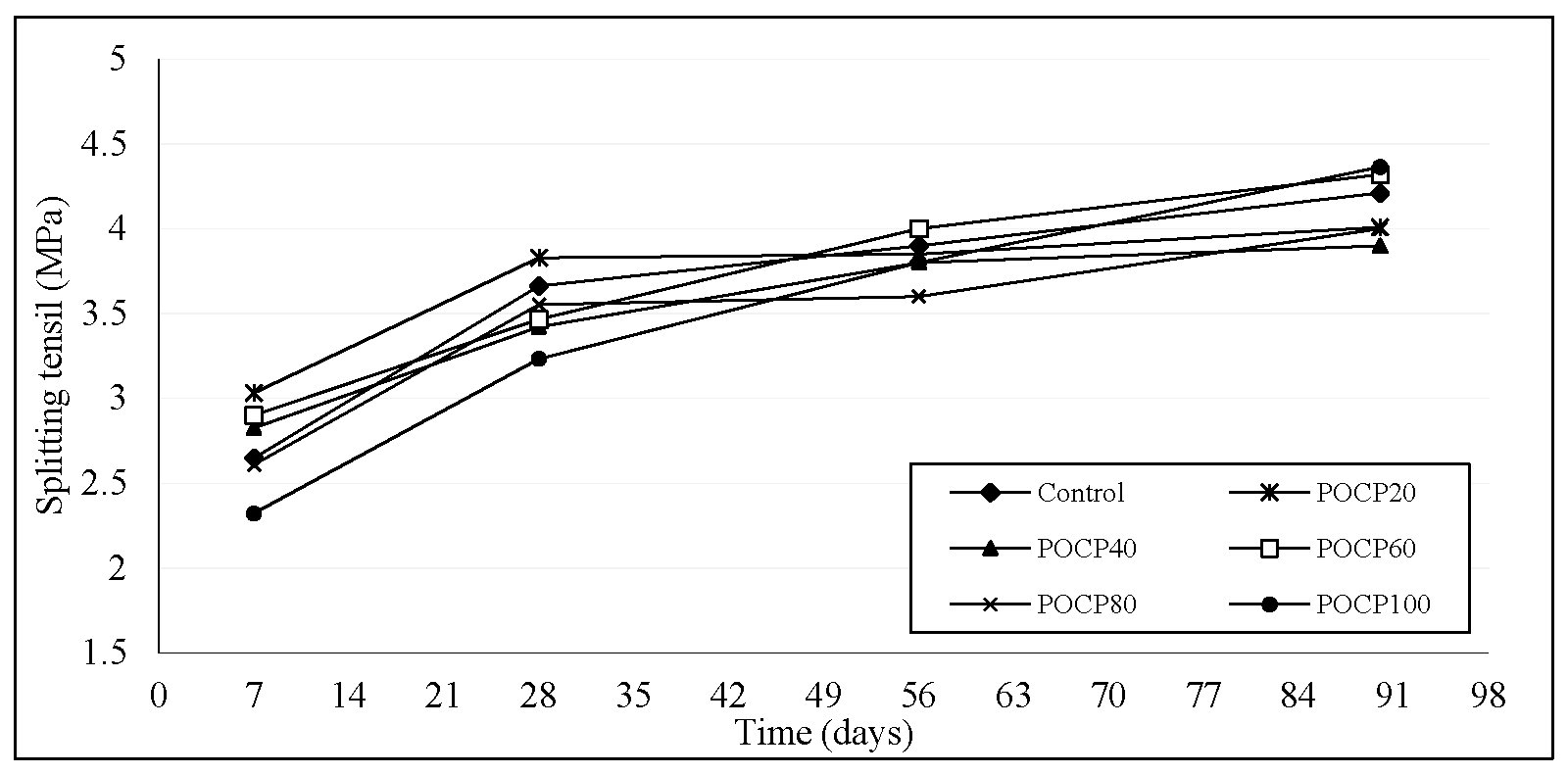
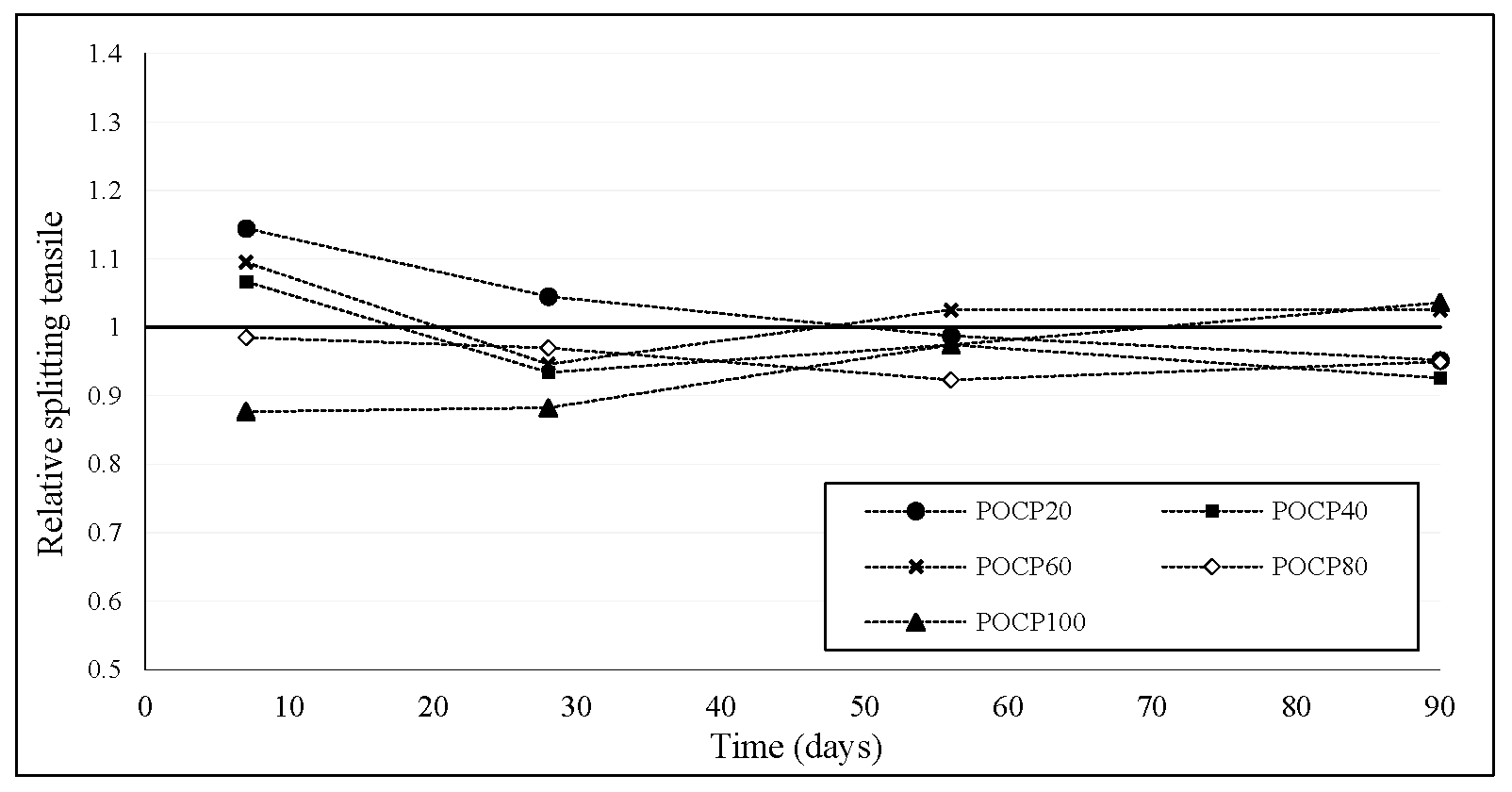
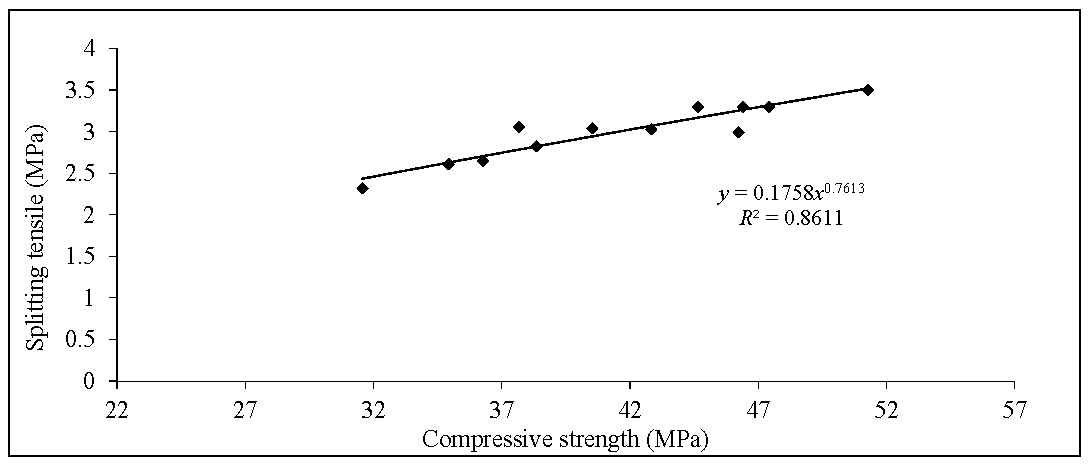
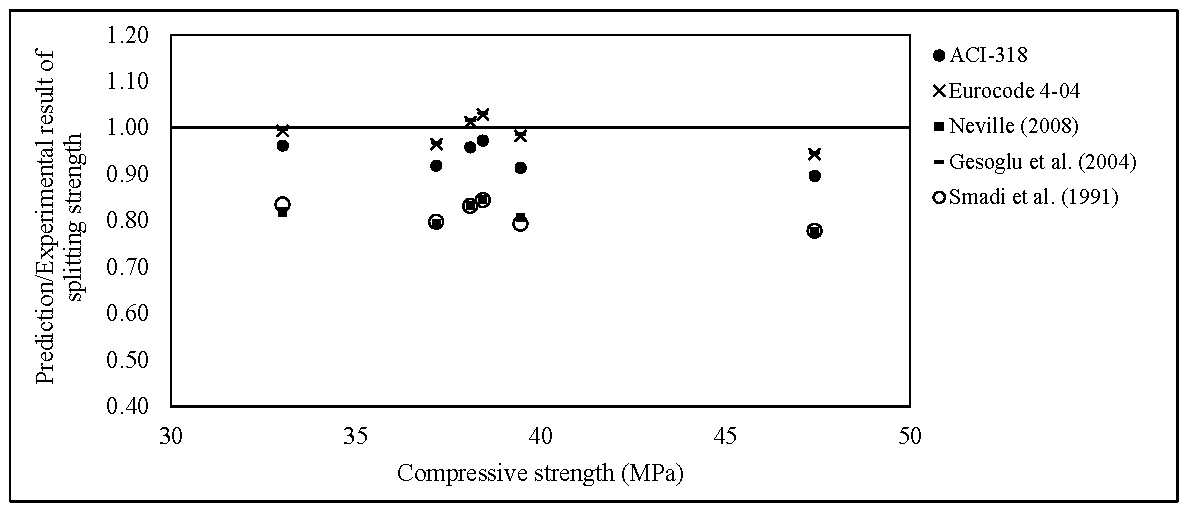

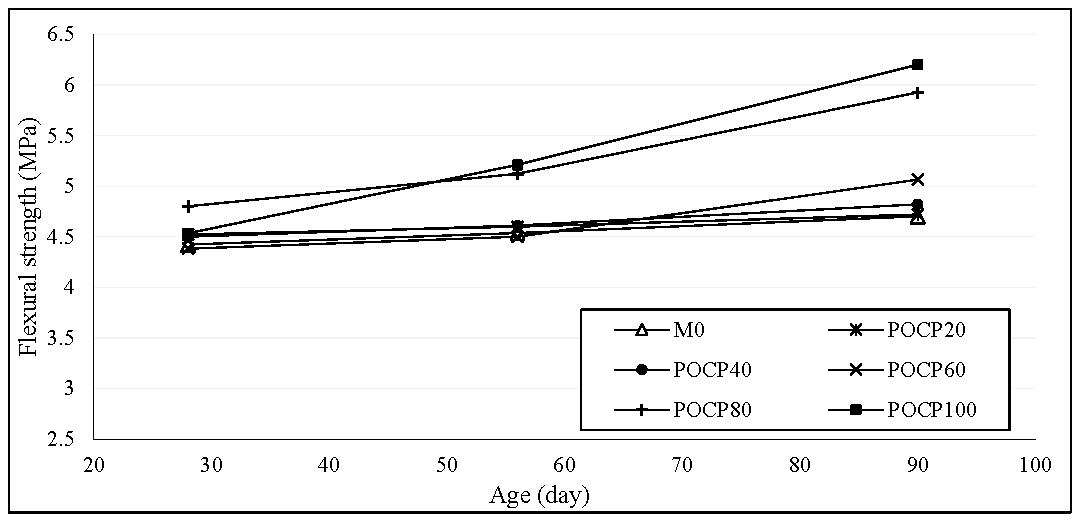

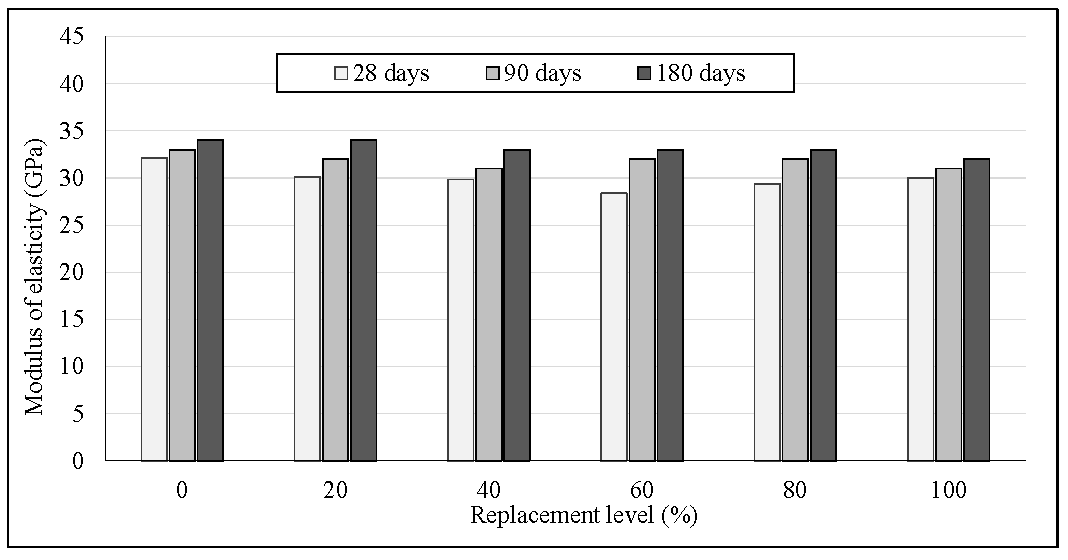
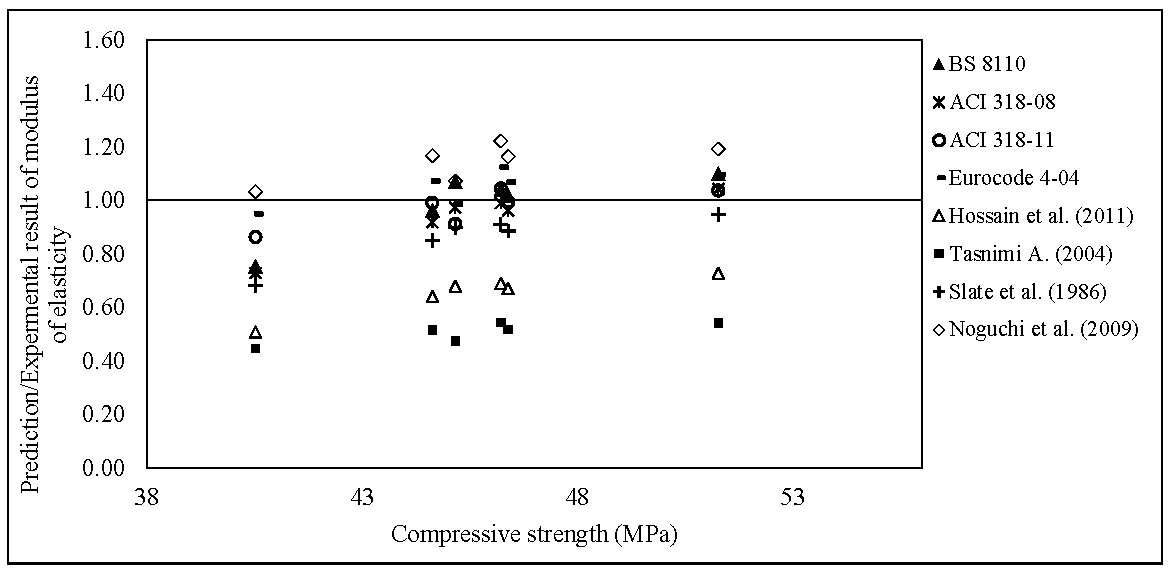
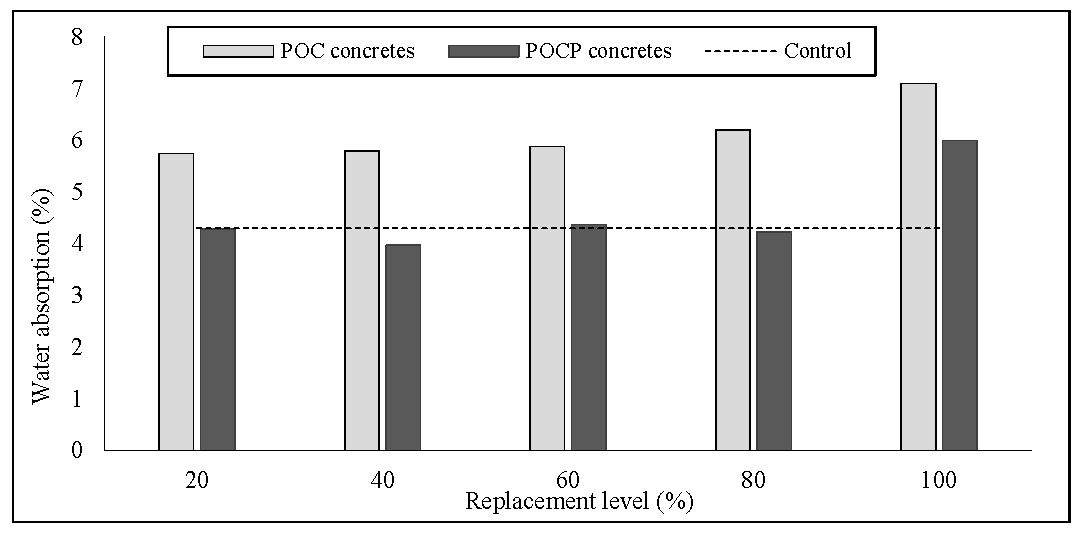

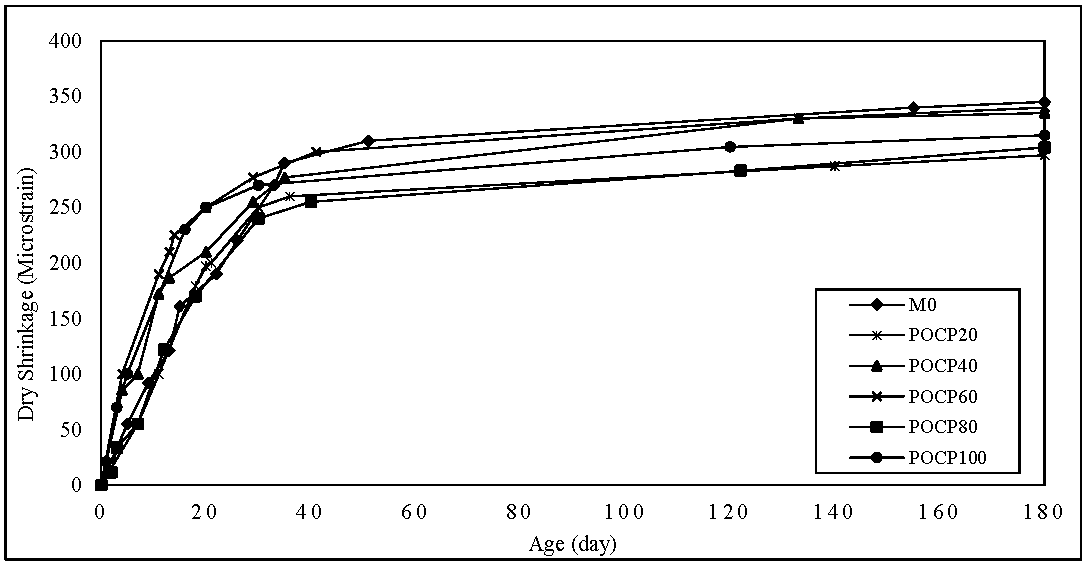

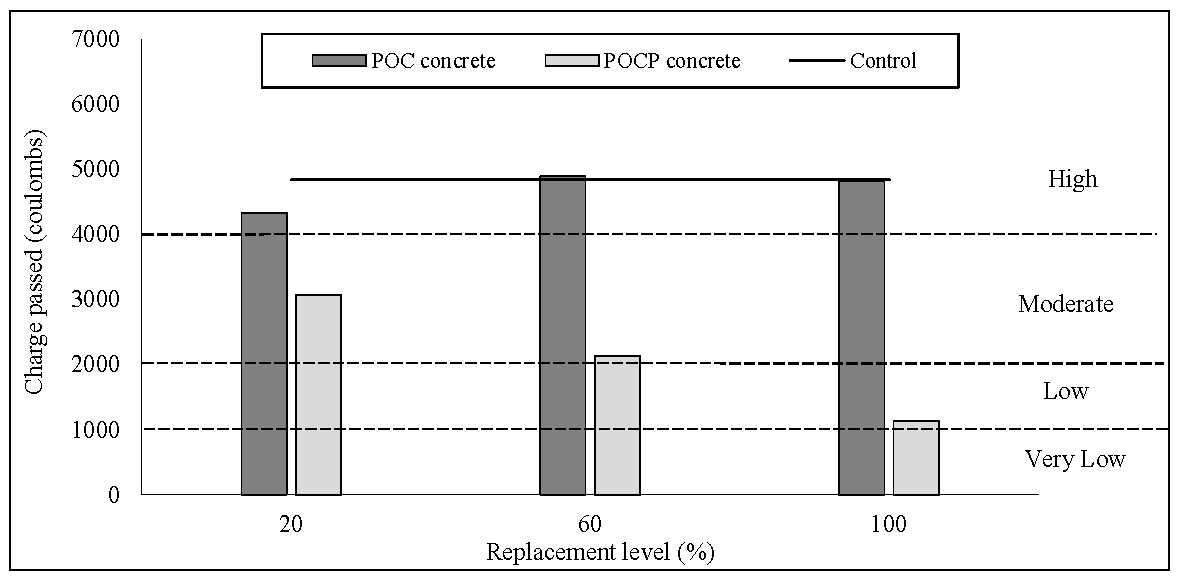
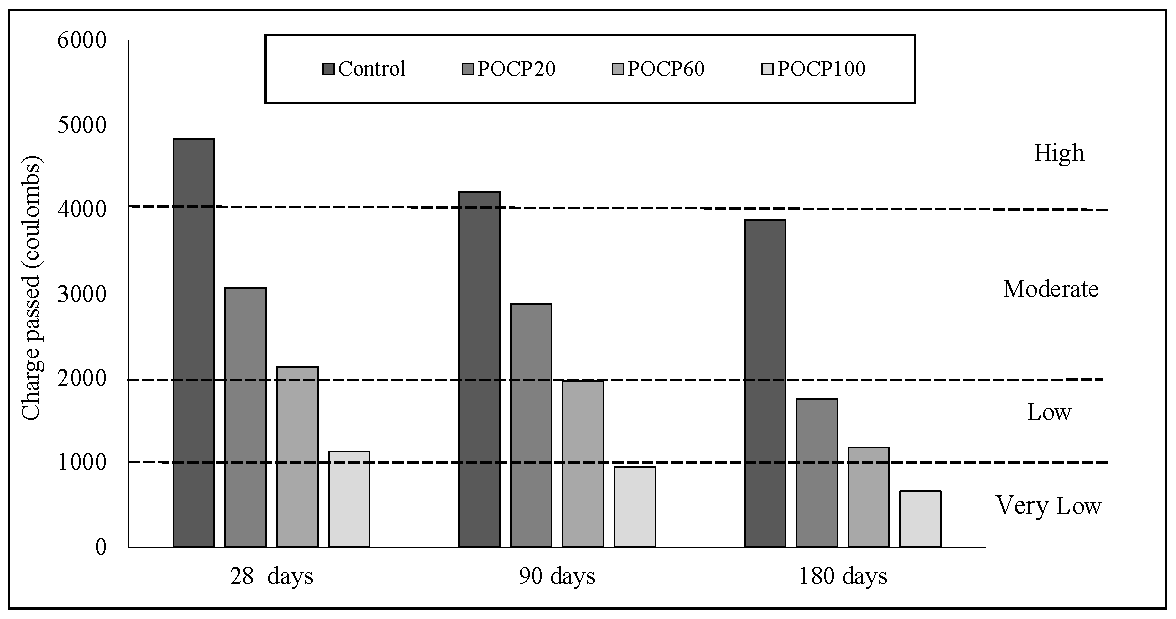
| Properties | Aggregates | ||
|---|---|---|---|
| River Sand | Coarse Aggregates | ||
| Granite | POC | ||
| Aggregate size (mm) | <4.75 | 4.75–14 | 4.75–14 |
| Specific gravity | 2.66 | 2.65 | 1.73 |
| Water absorption (%) | 0.39 | 0.58 | 3 ± 2 |
| Moisture content (%) | 0.08 | 0.28 | 1 ± 0.5 |
| Aggregate crushing Value (%) | – | 17.93 | 56.44 |
| Aggregate crushing value (Ten per cent fines) | – | – | 16.99 |
| Bulk Density (kg/m3) | 1301 | 1294 | 732 |
| Properties | OPC | POCP |
|---|---|---|
| Chemical Composition (%) | ||
| CaO | 64 | 6.37 |
| SiO2 | 20.29 | 59.9 |
| SO3 | 2.61 | 0.39 |
| Fe2O3 | 2.94 | 6.93 |
| Al2O3 | 5.37 | 3.89 |
| MgO | 3.13 | 3.3 |
| P2O5 | 0.07 | 3.47 |
| K2O | 0.17 | 15.1 |
| TiO2 | 0.12 | 0.29 |
| Mn2O3 | 0.12 | – |
| Na2O | 0.24 | – |
| others | 0.94 | 0.36 |
| Loss on ignition | 1.4 | 1.89 |
| Physical Properties | ||
| Specific gravity (g/cm3) | 3.15 | 2.59 |
| Particle Distribution | – | – |
| Average size, D (V, 0.5) | 27.98 μm | 20.97 μm |
| Passing 10.48 µm | 27.58 | 37.86 |
| Retained 10.48 μm, Passing 48.27 μm (%) | 45.80 | 34.05 |
| Retained 48.27 μm (%) | 26.62 | 28.09 |
| Replacement Level | ID | w/c Ratio | Mix Proportion (kg/m3) | ||||
|---|---|---|---|---|---|---|---|
| OPC | Fine Aggregate | Coarse Aggregate | |||||
| River Sand | POC | Granite | POC | ||||
| Control Mix | M0 | 0.53 | 420 | 760 | – | 1007 | – |
| Coarse Aggregate Replacement (Series POC) | |||||||
| 20% | POC20 | 0.53 | 420 | 760 | – | 806 | 131 |
| 40% | POC40 | 0.53 | 420 | 760 | – | 604 | 263 |
| 60% | POC60 | 0.53 | 420 | 760 | – | 402 | 394 |
| 80% | POC80 | 0.53 | 420 | 760 | – | 201 | 526 |
| 100% | POC100 | 0.53 | 420 | 760 | – | – | 657 |
| Replacement Level | ID | Cement (kg/m3) | POCP (kg/m3) | w/p Ratio | Fine Aggregate (kg/m3) | Coarse Aggregate (kg/m3) | |
|---|---|---|---|---|---|---|---|
| River Sand | Granite | POC | |||||
| Control Mix | M0 | 420 | 0 | 0.53 | 760 | 1007 | 0 |
| 20% | POCP20 | 420 | 70 | 0.51 | 760 | 806 | 131 |
| 40% | POCP40 | 420 | 93 | 0.48 | 760 | 604 | 263 |
| 60% | POCP60 | 420 | 108 | 0.46 | 760 | 402 | 394 |
| 80% | POCP80 | 420 | 156 | 0.45 | 760 | 201 | 526 |
| 100% | POCP100 | 420 | 203 | 0.43 | 760 | 0 | 657 |
| ID | Compressive Strength (MPa) | Flexural Strength (MPa) | Splitting Tensile (MPa) | ||
|---|---|---|---|---|---|
| M0 | 45.16 | 4.422 | 9.79 | 3.663 | 8.11 |
| POCP20 | 51.27 | 4.521 | 8.82 | 3.829 | 7.47 |
| POCP40 | 46.39 | 4.501 | 9.70 | 3.422 | 7.16 |
| POCP60 | 46.22 | 4.381 | 9.48 | 3.315 | 6.82 |
| POCP80 | 44.63 | 4.800 | 10.76 | 3.553 | 7.96 |
| POCP100 | 40.52 | 4.534 | 11.19 | 3.233 | 7.51 |
| Equation | Description | Reference | Equation No. |
|---|---|---|---|
| POCP concrete with cube compressive strength ranging between 40 and 51 MPa | This study | Equation (1) | |
| ACI-318-11 | [26] | Equation (2) | |
| Eurocode 4-04 | Eurocode 4-04 | Equation (3) | |
| From natural Tuff LWAC with a compressive strength as high as 60 MPa | [27] | Equation (4) | |
| For pelletized blast slag LWAC with cube compressive strength ranging from 10 to 65 MPa | [28] | Equation (5) | |
| Concrete with an artificial LWA has cube compressive strength ranging between 21 and 47 MPa | [29] | Equation (6) |
| Equation | Reference | Equation No. |
|---|---|---|
| [39] | Equation (7) | |
| [35] | Equation (8) | |
| [35] | Equation (9) | |
| [40] | Equation (10) | |
| [36] | Equation (11) | |
| [37] | Equation (12) | |
| [41] | Equation (13) | |
| [38] | Equation (14) |
| Charge Passed (Coulombs) | Chloride Ion Penetrability |
|---|---|
| >4000 High | High (H) |
| 2000–4000 Moderate | Moderate (M) |
| 1000–2000 Low | Low (L) |
| 100–1000 Very Low | Very Low (V.L) |
© 2017 by the authors. Licensee MDPI, Basel, Switzerland. This article is an open access article distributed under the terms and conditions of the Creative Commons Attribution (CC BY) license (http://creativecommons.org/licenses/by/4.0/).
Share and Cite
Abutaha, F.; Abdul Razak, H.; Ibrahim, H.A. Effect of Coating Palm Oil Clinker Aggregate on the Engineering Properties of Normal Grade Concrete. Coatings 2017, 7, 175. https://doi.org/10.3390/coatings7100175
Abutaha F, Abdul Razak H, Ibrahim HA. Effect of Coating Palm Oil Clinker Aggregate on the Engineering Properties of Normal Grade Concrete. Coatings. 2017; 7(10):175. https://doi.org/10.3390/coatings7100175
Chicago/Turabian StyleAbutaha, Fuad, Hashim Abdul Razak, and Hussein Adebayo Ibrahim. 2017. "Effect of Coating Palm Oil Clinker Aggregate on the Engineering Properties of Normal Grade Concrete" Coatings 7, no. 10: 175. https://doi.org/10.3390/coatings7100175
APA StyleAbutaha, F., Abdul Razak, H., & Ibrahim, H. A. (2017). Effect of Coating Palm Oil Clinker Aggregate on the Engineering Properties of Normal Grade Concrete. Coatings, 7(10), 175. https://doi.org/10.3390/coatings7100175





